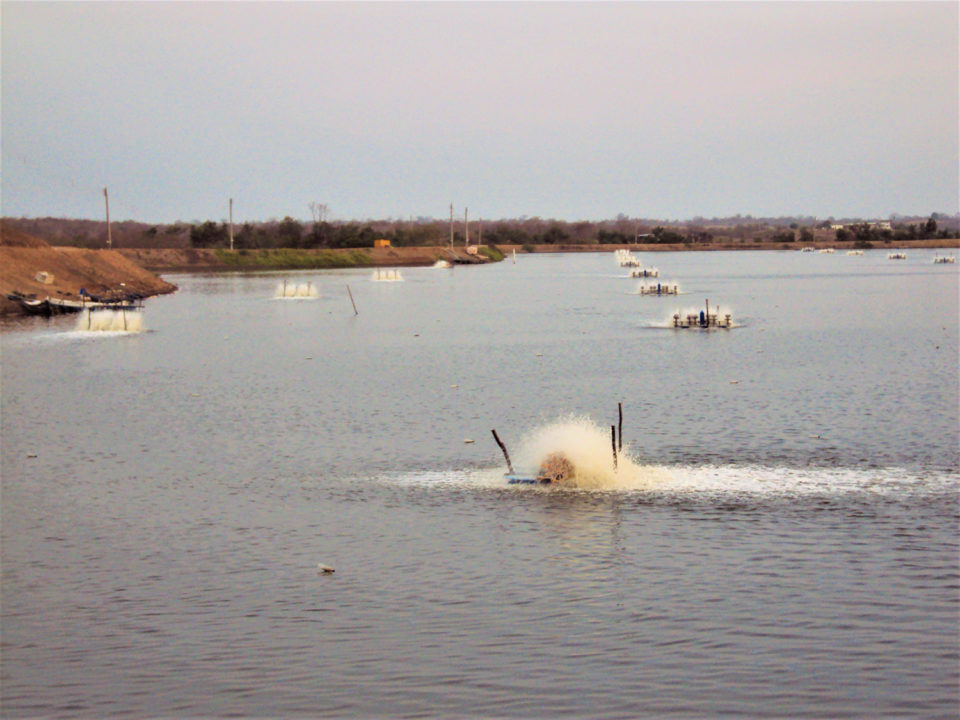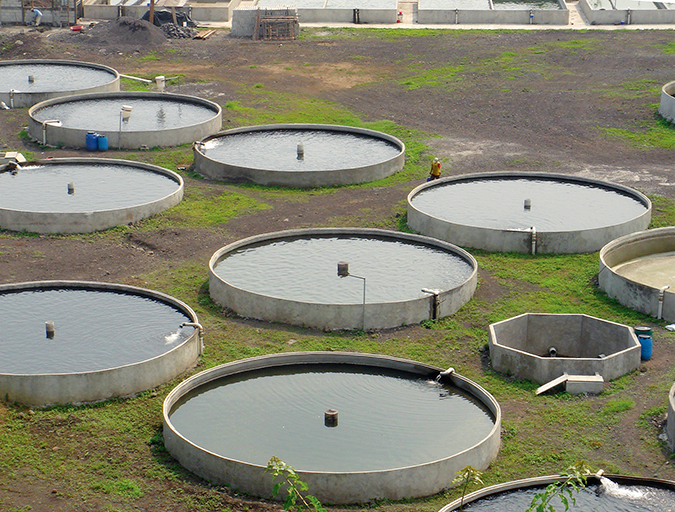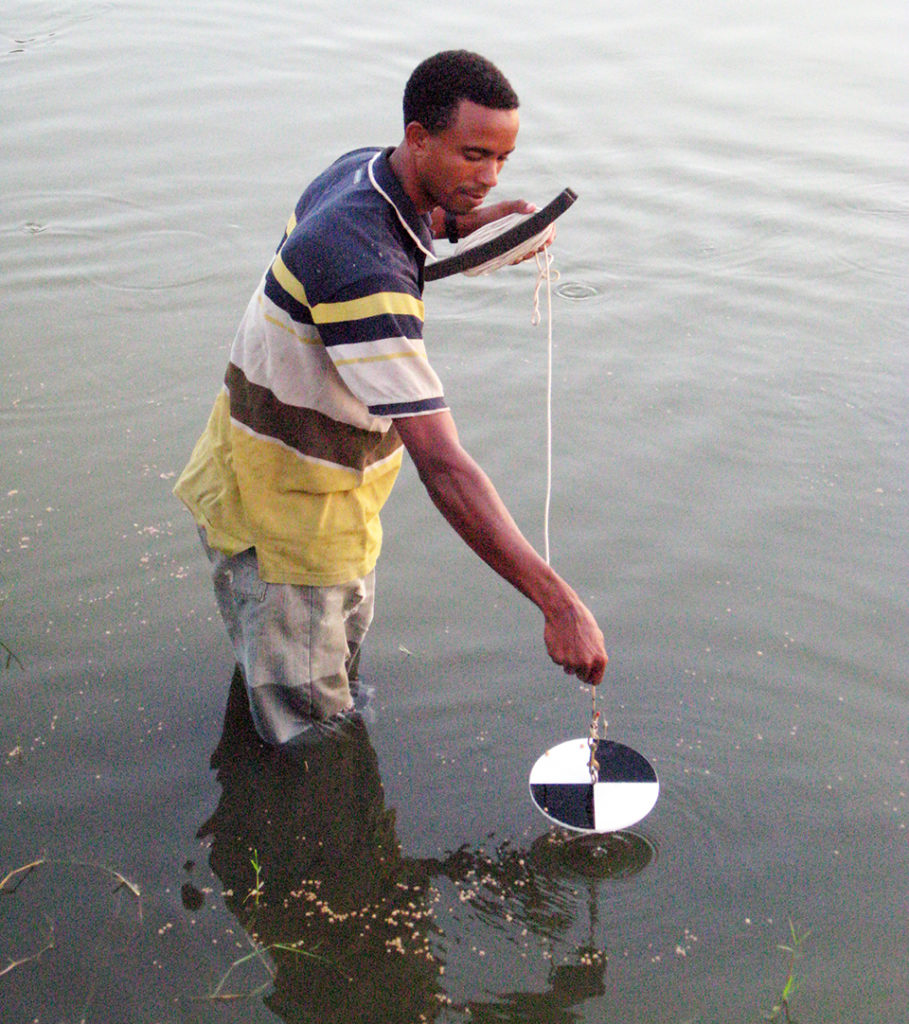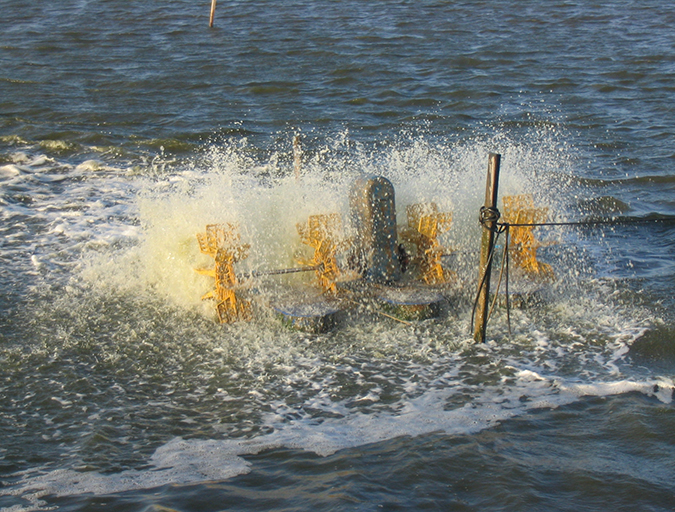Relevance to aquaculture producers

Aquaculture producers must be concerned with diverse substances dissolved and suspended in water. The concentrations or abundance of these substances may be either very large or extremely small. For example, the concentration of soluble inorganic phosphorus in aquaculture ponds often is less than 0.05 milligrams per liter (mg/L), the copper concentration might be only 10 to 15 micrograms per liter (mg/L), or the number of phytoplankton individuals might number 50 million to 100 million individual organisms per liter. These quantities are such small or large numbers that it is difficult for the mind to comprehend them.
Water molecules
A logical beginning point in trying to comprehend the relationships of the sizes and abundances of substances found in water is to consider the water molecules themselves. According to the Avogadro’s Constant (named after scientist Amedeo Avogadro, this constant is the number of constituent particles – usually ions, atoms or molecules – contained in the amount of substance given by one mole, the base unit of amount of substance in the International System of Units or System International or SI), a gram molecular weight (or mole) of a chemical compound or an atomic weight of an element contains 6.02 × 1023 molecules or atoms, respectively. The value 6.02 ×1023 often is called Avogadro’s number, and it also can be written as 602,000,000,000,000,000,000,000 or 602 sextillion individual atoms or molecules.
Water (H2O) has a molecular weight of 18 grams (g), and 1 liter (L) of water weighs 1,000 g. A molecular weight often is simply referred to as a mole. Thus, 1 L of water contains 55.6 moles of water. Multiplying by Avogadro’s number we find that 55.6 moles of water contains 3.34 × 1025 molecules. Water molecules obviously are very small, having radii of about 0.275 nanometers (nm) or 0.000000275 meters.
Inorganic ions
Inorganic ions such as nitrate, ammonium, phosphate, calcium, etc. are slightly larger than water molecules having radii of about 0.4 to 0.6 nm. The largest organic molecules in natural waters are humic substances with radii of 1 to 10 nm. Dissolved substances in water are considered to be those that will pass a filter with apertures of 2 micrometers (2,000 mm). Thus, some of the measured dissolved solids fraction is comprised of substances larger than common dissolved ions and organic compounds.
A concentration of 0.05 mg/L of soluble inorganic phosphorus seems like a very small amount. But, is it a very small number of phosphate ions? To answer this, we need to know that the phosphorus in soluble inorganic phosphorus has an atomic weight of 31 g. It follows that 0.05 mg (0.00005 g) of phosphorus represents 1.61 × 10-6 of an atomic weight of this element (0.00005 g phosphorus, 31 g phosphorus atoms per atomic weight). One atomic weight of phosphorus contains Avogadro’s number of atoms. Multiplying 1.61 × 10-6 moles phosphorus/L by Avogadro’s number reveals that 1 L of water containing 0.05 mg/L of soluble inorganic phosphorus has 9.7 × 1017 (940,000,000,000,000,000) phosphorus atoms (or phosphate ions) – a very huge number.
The problem for a phytoplankton cell needing phosphorus as a nutrient is that it must absorb phosphorus from among 3.34 × 1025 water molecules – there are 3.4 million water molecules [(3.34 × 1025 water molecules), (9.7 ×1017 phosphorus atoms)] for each dissolved inorganic phosphate ion.
Amazingly, planktonic algae are able to absorb phosphorus from among this vast number of water molecules. But absorption is not by simple diffusion, because the concentration of phosphorus in aquatic plants is much higher than it is in the surrounding water.Phytoplankton are small and have a large surface area with respect to their volume to increase contact with the water, but the movement of phosphorus into their cells depends upon an active, energy-consuming process.
Suspended matter
In addition to dissolved substances, water contains suspended matter consisting of soil particles (mainly fine silt and clay), bacteria, phytoplankton, zooplankton and organic detritus. These entities also are small (Table 1). Smaller soil particles, bacteria, and some of the plankton are not visible to the naked eye. Single particles (greater than 40 microns) are visible, although not in detail.
Boyd, substances, Table 1
| Particle | Length (microns) |
|---|---|
| Bacteria | 0.2 – 10 |
| Clay | 0.5 – 2 |
| Phytoplankton | 2 – 2,000 |
| Silt | 2 – 50 |
| Sand | 50 – 2,000 |
| Zooplankton | 100 – 2,500 |
| Organic detritus | 0.2 – 2,500 |
Note: single particles larger than 40 microns are considered to be visible to the naked eye. This size is equivalent to 40,000 nm, 0.04 mm, or 0.0016 inch.
Elevated concentrations of colored dissolved compounds such as humic substances, small clay particles and small phytoplankters and zooplankters impart color to water despite their individual particles not being visible. For example, phytoplankton blooms color water a shade of green, while humic substances tint water with a black hue or combine with iron to create a shade of yellow. Bacteria usually are not visually detectable, and this is likely the reason that they are the most misunderstood of the particles in pond water.
A small particle has a very large surface area related to its volume. The volume [volume = (4/3)(3.1416)(cube of radius)] of a single, spherical phytoplankton organism of 50 microns in diameter would be 5.23 × 10-13 cubic meters, while the surface area [area = (4)(3.1416)(square of radius)] of this organism would be 3.14 × 10-8 square meters. In a liter of water, 50,000,000 such organisms would have a combined volume of 26.2 milliliters and a combined area of 1.57 square meters.
Small particles of soil are very absorptive because of their large surface area. Also, the large surface area of planktonic algae increases their contact with substances in the water to facilitate absorption of nutrients.
Turbidity
Seawater has a much greater concentration of the major inorganic ions than does freshwater. Nevertheless, light will penetrate as deeply into normal seawater as it will into normal freshwater. Most common ions do not affect the clarity of water, but large molecules such as those of humic substances interfere with light penetration and impart color to water.
The larger particles in water interfere with light penetration and cause turbidity. Turbidity is usually beneficial when it results from plankton, because these organisms serve as food for shrimp, fish and other larger aquatic animals. Plankton turbidity also is helpful by limiting visibility into the water to protect fish and shrimp larvae from predaceous aquatic organisms. Turbidity also lessens the ability of predaceous birds to see and capture fish and shrimp from aquaculture ponds or other culture facilities. Finally, reduction in light penetration by turbidity lessens the likelihood of nuisance infestations of aquatic macrophytes (often referred to as aquatic weeds). Of course, too much plankton – particularly phytoplankton – can lead to low concentrations of dissolved oxygen at night.
Turbidity from suspended soil particles also limits predation on small culture animals and growth of underwater aquatic weeds. But turbidity from soil particles usually is considered to be negative than positive in natural aquatic environments, because it lessens light penetration and photosynthesis.
Of course, in aquaculture systems to which feeds and aeration are applied, turbidity of suspended soil particles if not necessarily detrimental. It limits the amount of phytoplankton biomass and minimizes the daily oscillations in dissolved oxygen concentration. It also should be noted that “off-flavor” in the flesh of culture species caused by certain species of blue-green algae is seldom a problem in ponds turbid from suspended soil particles.
Now that you've reached the end of the article ...
… please consider supporting GSA’s mission to advance responsible seafood practices through education, advocacy and third-party assurances. The Advocate aims to document the evolution of responsible seafood practices and share the expansive knowledge of our vast network of contributors.
By becoming a Global Seafood Alliance member, you’re ensuring that all of the pre-competitive work we do through member benefits, resources and events can continue. Individual membership costs just $50 a year.
Not a GSA member? Join us.
Author
-

Claude E. Boyd, Ph.D.
School of Fisheries, Aquaculture and Aquatic Sciences
Auburn University
Auburn, Alabama 36849 USA
Tagged With
Related Posts

Health & Welfare
Ammonia toxicity degrades animal health, growth
Ammonia nitrogen occurs in aquaculture systems as a waste product of protein metabolism by aquatic animals and degradation of organic matter, or in nitrogen fertilizers. Exposure can reduce growth and increase susceptibility to diseases in aquatic species.

Responsibility
Calcium and magnesium use in aquaculture
Aquatic plants and animals get the essential nutrients calcium and magnesium from water and food. Calcium concentrations impact the hydration and development of eggs in a hatchery, where calcium carbonate precipitation can be troublesome.

Responsibility
Light penetration in water
Light penetrating water is scattered and absorbed exponentially as it passes downward. The presence of dissolved organic matter and suspended solids further impedes light penetration, and different types of solids absorb different wavelengths.

Responsibility
Does Coriolis force impact aerator placement in aquaculture ponds?
The Coriolis effect has no bearing on aerator placement and aquaculture pond management. The most important consideration with mechanical aeration is to provide a sufficient amount to maintain adequate dissolved oxygen concentration.

